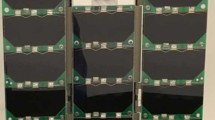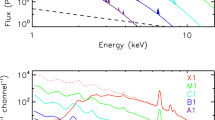Abstract
The SOLAR-A spacecraft has spectroscopic capabilities in a wide energy band from soft X-rays to gamma-rays. The Wide Band Spectrometer (WBS), consisting of three kinds of spectrometers, soft X-ray spectrometer (SXS), hard X-ray spectrometer (HXS) and gamma-ray spectrometer (GRS), is installed on SOLAR-A to investigate plasma heating, high-energy particle acceleration, and interaction processes. SXS has two proportional counters and each counter provides 128-channel pulse height data in the 2–30 keV range every 2 s and 2-channel pulse count data every 0.25 s. HXS has a NaI scintillation detector and provides 32-channel pulse height data in the 20–400 keV range every 1 s and 2-channel pulse count data every 0.125 s. GRS has two identical BGO scintillation detectors and each detector provides 128-channel pulse height data in the 0.2–10 MeV range every 4 s and 4-channel pulse count data (0.2–0.7, 0.7–4, 4–7, and 7–10 MeV) every 0.25–0.5 s. In addition, each of the BGO scintillation detectors provides 16-channel pulse height data in the 8–100 MeV range every 4 s and 2-channel pulse count data (8–30 and 30–100 MeV) every 0.5 s. The SXS observations enable one to study the thermal evolution of flare plasma by obtaining time series of electron temperatures and emission measures of hot plasma; the HXS observations enable one to study the electron acceleration and heating mechanisms by obtaining time series of the electron spectrum; and the GRS observations enable one to study the high-energy electron and ion acceleration and interaction processes by obtaining time series of electron and ion spectra.
Similar content being viewed by others
References
Chupp, E. L.: 1984, Ann. Rev. Astron. Astrophys. 22, 359.
Chupp, E. L.: 1987, Phys. Scripta T18, 5.
Dennis, B. R.: 1988, Solar Phys. 118, 49.
Forrest, D. J.: 1990, 21st Int. Cosmic Ray Conf. 7, 241.
Kondo, I., Yoshimori, M., Okudaira, K., Hirasima, Y., Igarashi, T., Akasaka, M., Nishimura, J., Yamagami, T., Ohki, K., and Watanabe, T.: 1990, 21st Int. Cosmic Ray Conf. 7, 268.
Watanabe, T., Tanaka, K., Akita, K., and Nitta, N.: 1983, Solar Phys. 83, 107.
Yoshimori, M.: 1988, in N. Gehrels and G. H. Share (eds.), Nuclear Spectroscopy of Astrophysical Sources, AIP Conf. Proc. No. 170, p. 401.
Yoshimori, M.: 1989, Space Sci. Rev. 41, 85.
Yoshimori, M. and Okudaira, K.: 1988, Nucl. Instr. Meth. A272, 880.
Yoshimori, M., Okudaira, K., Hirasima, Y., Yanagimachi, T., Kondo, I., Ohki, K., Watanabe, T., Nishimura, J., Yamagami, T., Murakami, T., Ito, M., and Yoshida, A.: 1988, Nucl. Instr. Meth. A264, 436.
Author information
Authors and Affiliations
Additional information
After the launch the name of SOLAR-A has been changed to YOHKOH.
Rights and permissions
About this article
Cite this article
Yoshimori, M., Okudaira, K., Hirasima, Y. et al. The Wide Band Spectrometer on the SOLAR-A. Sol Phys 136, 69–88 (1991). https://doi.org/10.1007/BF00151695
Received:
Revised:
Issue Date:
DOI: https://doi.org/10.1007/BF00151695




